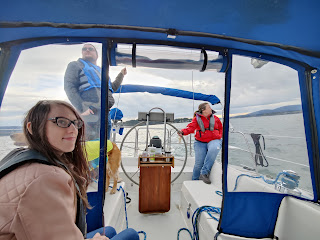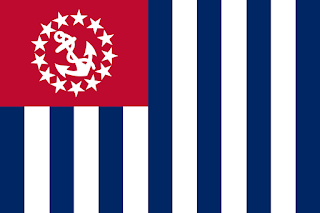We have wanted to take our little boat up to the San Juan islands for years.
Having spent exactly one night on the boat before, this was a pretty big step
for us. Our friends Boris and Mayli were planning a trip up there for late
August, and asked if we wanted to join them. There was so much to do to get
ready.
Besides provisioning the boat, we needed a dinghy. We bought one very cheap
dinghy from Craigslist. It had leaks that we wouldn't be able to repair in
time. So we bought another dinghy, a West Marine RU-250, along with a Mercury
Marine 2.5 hp outboard. To inflate it, we got a electric air pump and EXP Pro
48 Lithium Ion battery pack. (The battery pack is useful for a lot of things.)
To tow it, we rigged a harness that distributes the pull between the rings on
the front with New England Ropes Dinghy Tow Rope.

|
|
Our RU-250 and Mercury Marine outboard.
|
We also needed a way to charge the batteries while at anchor. We bought a
gas-powered generator. It provides a 20 amp socket that our shore power cable
plugs directly into. And speaking of anchors, our little 8 pound Danforth
wasn't going to keep us feeling comfortable, so we bought a Rocna 10 (10 kg,
22 lbs) anchor, 22 feet of chain, 250 feet of 3/8" line and a swivel. We also
got an anchor ball. We got a radar reflector, just in case we ran into fog, so
we wouldn't get run down in our tiny boat (fortunately, no fog on the trip).

|
|
Headed out, towing the dinghy.
|
We got everything on the boat. It got to be 2 p.m. August 22nd 2021. We
debated whether it was too late to head out, but we had a schedule to meet
(always a problem on a boat)! Left dock and headed out. We arrived at Langley
(South Whidbey Harbor) on Whidbey Island around dusk.
We used to VHF to call into Langley for a slip, but there was no answer. The
telephone number said to call on the VHF. However, coming into the marina
there was a sign on a slip saying "open", so we pulled right in and tied up.
We paid at the box, and got the bathroom code number from another mariner. All
good! We were entertained by the seals on the dock all night that would bark
at us if we passed too close, but wouldn't budge.
The next morning, we headed out. We tried to put up sails, but there wasn't
enough wind, and resorted back to motoring. Up through the Swinomish channel,
past La Conner, and into Anacortes Cap Sante Marina. Called on the VHF and
they assigned us a 50' slip for our Catalina 22. Not sure if they misheard our
LOA! It was entertaining to be next to boats that probably have cleats that
cost more than our boat.
The next morning we headed out. Crossing through Guemes channel with a strong
tide in our favor, we hit 9.6 knots, I think a record for a Catalina 22! We
crossed Rosario Strait with no problems, around the north end of Lopez Island,
and into Friday Harbor marina on San Juan island. Soon after arriving, Boris
and Mayli pulled in as well.

|
|
Proof that a Catalina 22 can go 9.6 knots.
|
The next morning, we got showers at the Marina, refueled the five gallons of
gas we'd used since the start of the trip, and headed out to Westcott Bay near
the English camp of the
Pig War. We sailed
a bit on the way, which was gloriously good sailing. In Westcott Bay, we
anchored for the first time ever! Dropped the Rocna anchor, tied the rode to
the forward cleat, put it in reverse and done. That evening we set the anchor
alarm and it didn't budge. Boris sent up the drone, and caught this footage of
us at anchor.
Fantasia at Westcott Bay (those are seat cushions drying on top)
We took our dinghy for a nice test ride out to the English Camp. In 1859, the
United States and England had a cold war on San Juan island contesting the
border between the U.S. and Canada. Both claimed the San Juan islands.
Eventually, a decision was made by a neutral third party that the San Juan
islands were owned by the United States and the hostilities ended with the
only casualty of the war being a pig, thus the name "The Pig War".
The next day Sandi cooked pancakes on the deck for breakfast. In the
afternoon, we took the dinghy around to Roche Harbor, visiting the town and
the sculpture park.

|
|
Mayli at the sculpture park.
|
The next morning, we topped off the batteries with the generator, and headed
back to Anacortes, passing between Orcas Island and Shaw Island. It was
pouring rain at times. As we crossed Rosario Strait, Greg checked the bilge
and discovered water, which was disconcerting as we have never had any real
water in the bilge. Water seemed to be seeping in aft of the keel trough. We
got to Cap Sante Marina and Greg raced over to West Marine to get some epoxy
before they closed. After laying down some epoxy which slowed the ingress, we
debated what to do, as sailing for another day or two with an unknown source
of water seemed inadvisable.
After thinking about it, we decided to have Connie come up and get Sandi, go
down and get the trailer, and bring it back. Greg stayed with boat overnight
during which the water leak seem to subside. The next morning, Sandi drove up
with the trailer along with Devon and Taylor. We moved the boat over to the
boat lift and took down the mast. The guys at the lift took the boat out and
dropped it on the trailer. And we drove it back to Kenmore. Thus ending our
trip.
While this ended on a downbeat, we considered this trip a success!

|
|
Fantasia safely parked at the end of the trip.
|

|
|
Our route. (Open Street Maps)
|













































